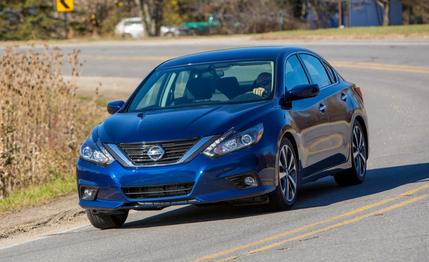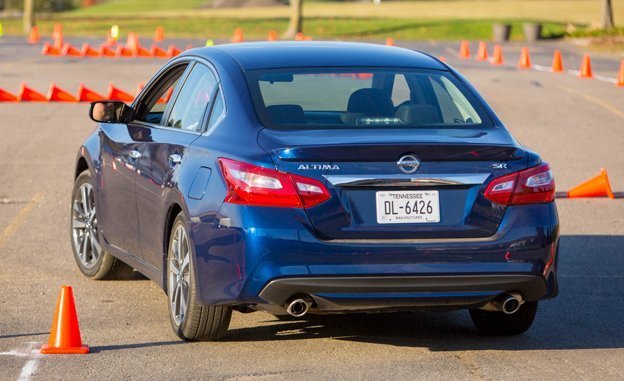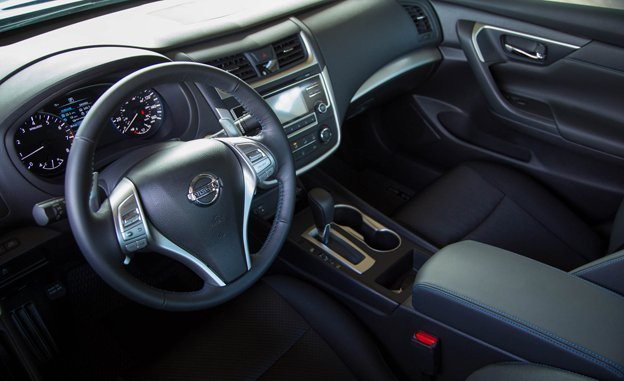 First Drive Review
First Drive Review
There’s an interesting phenomenon that happens in Olympic competition, wherein silver medalists tend to feel less satisfied with their accomplishment than those who win bronze. Call it the “second place is just the first loser” principle, but runners-up are seemingly tormented by not winning, whereas those finishing third are more likely to recognize the accomplishment of beating nearly everyone in the world.
It’s that attitude that informs the fifth-generation Nissan Altima, which has had a lock on third place in mid-size-sedan sales since it was introduced in summer 2012. Confident in the Altima’s near-universal appeal, Nissan’s mid-life-cycle refresh for 2016 is concerned more with reinforcing the car’s desirability than amending weaknesses. After all, moving over a million units of any automobile is an accomplishment.

More in the Family
The most obvious updates to the new Altima come in its new front and rear fascias, which now resemble those of the Murano and the new Maxima. Fresh head- and taillights necessitated sheetmetal changes to the hood, fenders, and trunk, making this more of an overhaul than is usual in the industry. The look certainly works to give the Altima a more current family resemblance, although this styling language still seems awkward to our eyes. Especially if there’s a Mazda 6 parked nearby.
Updates are less apparent inside, but Nissan has applied some of the same patterned plastic trim that first debuted in the Murano. The Altima-specific design looks something like fossilized leaves preserved in amber, and it’s bound to frustrate owners in the way it seems dirty when it catches the light just so. But the cabin remains a quiet and comfortable place to while away a commute, thanks to improved insulation and acoustic laminated glass. Some road noise does filter through, but an improved version of Nissan’s continuously variable transmission no longer drones away at high rpm. The so-called “D-step” CVT, borrowed from the Murano and Maxima, instead behaves like a traditional automatic, dropping revs to emulate an upshift.
Engines carry over from last year, although the 2.5-liter four-cylinder gets some small efficiency tweaks including a bump in compression ratio from 10.0:1 to 10.3:1. Horsepower and torque are unchanged at 182 and 180 lb-ft, respectively, as is the coarse groan of the ancient engine whenever it’s really pushed. But combined with underbody panels, active grille shutters, and the fuel-sipping transmission, the tweaked four-cylinder allows the Altima to achieve a 1-mpg gain in highway fuel-economy testing. Nissan says the car will carry EPA ratings of 39 mpg on the highway, 27 mpg in the city, and 31 combined.
Enter the SR
The evergreen VQ V-6 with 3.5 liters of displacement and 270 horsepower returns (with a CVT, natch), even as Nissan expects it to account for only six percent of sales. That’s actually twice the volume in the outgoing car; Nissan’s projections are based on the introduction of a new SR trim. This is largely a handling package, although SR cars will get some mild aesthetic enhancements including a small spoiler and unique interior trim.

Four-cylinder SR models sit in the middle of the pricing range, starting at $25,295, and a V-6 Altima in SR trim will set you back $28,215. The base price for the Altima is up $200 from last year, to $23,325, while increases on other trims can add as much as $740 to the MSRP.
Sadly enough, Nissan didn’t have any V-6 cars of any trim level available to drive at its launch event, but we did get to try out the four-cylinder SR and came away encouraged. Being saddled with an old engine and a CVT, Nissan’s engineers were constrained in what they could do to make a sportier Altima. Taking that into consideration, the SR comes off as well as can be imagined.
Nissan tells us the standard Altima has slightly stiffer rear springs that reduce body roll a bit from last year, yet the SR improves on this with thicker tubular anti-roll bars and a unique damper calibration. In the front, the standard Altima’s 22.2-mm bar is replaced with one that is 24.2 mm in diameter, and in the rear a 26.5-mm bar replaces the standard 22-mm one, changes that Nissan says reduce body roll by 21 percent. The revisions to the suspension also help the Altima’s brake-based torque-vectoring system better assist the car in turning. We can expect an oddly specific 12.5-percent improvement in grip once we get the Altima SR out on the skidpad, says Nissan.
The Altima’s electrohydraulic power steering has been reprogrammed across the lineup for a weightier feel and a bit more feedback, and on the street the SR feels poised and well-planted. Add its standard 18-inch wheels and column-mounted shift paddles to exercise a bit of control over the CVT, and the SR is certainly the most appealing Altima, even if it falls short of being a true mainstream sports sedan. Whether or not it remains third in the sales race, the updated Altima should leave its legions of buyers satisfied.